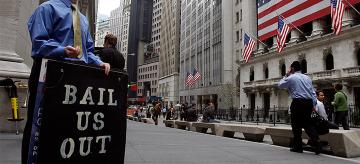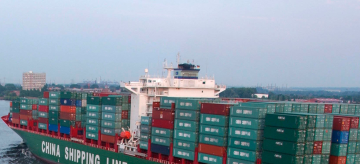What Are the World Bank and the International Monetary Fund?
What's the difference between the World Bank and the IMF? Understand two institutions that undergird global development and the international monetary system.
History of the World Bank and the IMF
World War II laid waste to Europe. It destroyed entire cities, created dire food and fuel shortages, and left the financial systems of countries like Germany in disarray. Economic conditions were so dire that German citizens resorted to using cigarettes as money.
Western leaders feared this extreme poverty could open the door to communism and a resurgence of violence. So in 1944, as the war was coming to an end, representatives from forty-four nations met in Bretton Woods, New Hampshire. The world leaders met to discuss ways to promote economic recovery and build a global monetary system designed to ensure stability and prevent future wars. Most notably, two historic institutions emerged from that conference: the World Bank and the International Monetary Fund (IMF).
For over seventy years, those two organizations—traditionally led by a U.S. citizen and a European, respectively—have promoted trade, development, and economic stability around the world. But their policies have also proved imperfect—and at times even harmful.
This resource breaks down the successes and failures of the World Bank and the IMF. It also explores the roles of those institutions in a global financial landscape that looks markedly different than it did more than seventy-five years ago.
What is the World Bank?
The World Bank was founded in 1944 to provide loans for rebuilding postwar Europe. The initial purpose of the institution was to support the continent’s long-term development. Today, its mission has expanded to ending extreme poverty and promoting shared prosperity around the world.
To achieve this goal, the World Bank issues loans and grants to low- and middle-income countries that it classifies as developing countries. For example, if a government wants to build a multibillion-dollar dam or hundreds of new schools, the World Bank can assist with funding and technical support. Over the years, the World Bank has lent hundreds of billions of dollars to developing countries. These loans include tens of billions of dollars annually to the world’s poorest countries, at concessional (below-market) interest rates. It also provides grant financing to poorer countries.
The World Bank’s projects are wide-ranging, and many have been quite successful. In India—the country with the world’s largest number of people living in extreme poverty—the World Bank has contributed to the country’s development. The institution has helped improve roads in rural areas and ensured that almost every child attends elementary school. Elsewhere, the World Bank has devoted billions of dollars toward the global AIDS response and supplied countries with cutting-edge development research. Moreover, the World Bank supported vital reconstruction work in Bosnia, Colombia, and El Salvador following those countries’ civil wars.
World Bank Project Case Studies
Click through to learn about each project.
However, the World Bank is not without its flaws. Projects have at times ignored the opinions of local communities, displaced indigenous groups, and struggled to fight widespread corruption. At a more fundamental level, experts question whether the World Bank fully understands what policies best reduce poverty. The organization has been criticized for shifting between different approaches (like tackling corruption and large infrastructure projects) that don't necessarily address poverty directly.
Despite these concerns, the World Bank plays an important role in global development, as over seven hundred million people live in extreme poverty.
What is the IMF?
The IMF serves as the world’s “financial firefighter.” When a country’s economic problems threaten to undermine global financial stability, the IMF is called upon to douse the flames. To put out these fires, the IMF can provide loans to alleviate a country’s economic stress. All member countries contribute funds to the IMF, which pools those funds to lend to countries in trouble.
How does the IMF know when trouble occurs? Countries agree to allow the institution to monitor their economic and financial policies. The IMF uses this information to issue every country a regular (usually annual) report card known as an Article IV consultation.
The IMF judges a country’s financial state by looking at two main factors: its fiscal position—the size of the government’s budget deficit and the amount of debt it has outstanding—and its balance of payments, or how much money is flowing in and out of a country. If a country is running out of foreign exchange reserves or otherwise needs help, the IMF typically offers a loan. The IMF also provides advice on how to structure economic policies, such as taxation and government budgets. With certain votes requiring 85 percent approval and the United States controlling 16.5 percent of the organization’s total voting power, the United States effectively has veto power over critical policy decisions.
Learn more about monetary policy.
One of the IMF’s most influential interventions followed the 2008 global financial crisis, which left Europe’s economies reeling. Greece in particular was unable to raise money in the private market because of its exceedingly high debt. That created a problem for not just Greece but all members of the eurozone. The situation was particularly precarious because no process had been established for bailing out a country in financial distress in the eurozone. European financial experts were concerned that a messy default would trigger trouble in Europe’s already weak banks. Experts also feared that the crisis would lead to Greece and perhaps others leaving the common currency. Faced with such conditions, the IMF joined the eurozone countries in developing a program to help keep Greece in the eurozone. The IMF provided thirty billion euros, and eurozone countries initially put up eighty billion euros, raising that amount steadily over time. Total lending ultimately reached 289 billion euros. But in the process, the IMF also joined the European Central Bank and the European Commission in forcing Greece to implement reforms. These austerity policies caused sustained economic decline and enormous unemployment in the country.
As the Greece example illustrates, IMF loans can be controversial. They often stipulate austerity measures—policies that mandate decreased government spending, increased taxation, or a combination of the two. Those policies are intended to boost government revenue, cut down on debt, and allow the country to regain access to funds from the global financial market. However, a decrease in spending often means cuts to government services and welfare programs, harming some of society’s poorest members. Greek citizens protested after austerity measures led to pension cuts and tax increases amid a period of record unemployment. Some critics claim that austerity measures are counterproductive to economic recovery. Although the IMF can use its funding to have poor countries make economic reforms, the institution has significantly less leverage in encouraging rich countries to adjust their financial and economic behaviors.
What is the future of the World Bank and the IMF?
The IMF was intended to be at the center of the world’s system for managing financial crises. Today, its position is being challenged. Rather than turning to the IMF, some governments are instead finding support from other countries with significant reserves. In 2015, Pakistan turned to China and Arabian Gulf countries for loans before ultimately going to the IMF. And Turkey has turned to Qatar for support in bolstering its depleted central bank reserves.
Additionally, the World Bank’s position as the leading development lender is under even more threat as, in the years preceding the COVID-19 pandemic, China’s policy banks—the China Development Bank and the Export-Import Bank of China—have been bigger sources of development finance globally than the World Bank.
Why would a country turn to another government as opposed to the World Bank or the IMF? China typically does not mandate policy changes like austerity measures or conditional loans on improvements in human rights. Additionally, such loans are often not made public, allowing countries like Kyrgyzstan and Niger to keep their financial activities secret. But countries like China also have their own motivations for lending—whether for profit or political gain.
Although other countries and institutions have been presented as alternatives to the World Bank and the IMF, they are not necessarily better than the existing systems. The COVID-19 pandemic showed that, even with their flaws, the World Bank and the IMF remain important. The IMF made over $250 billion in financing available to more than eighty countries affected by the crisis, and the World Bank committed over $200 billion in response to the pandemic. Without those two institutions and their strong balance sheets and staff of professionals, countries struggling to manage the pandemic would have had difficulty mobilizing a comparable global response.



